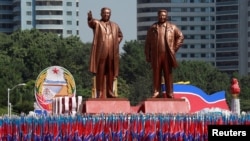Regional defense analysts say North Korea has apparently begun preparations for a major military parade expected next month, when they say it may unveil a major new weapons system.
Satellite imagery from August 31 shows thousands of troops in formation and hundreds of vehicles parked near the Mirim Parade Training Ground in the eastern part of the capital, Pyongyang, where parade rehearsals are usually conducted.
38 North, a US think tank website that published the satellite imagery, says the parade training appears to have started later than usual, perhaps because of anti-pandemic measures or severe weather that has recently battered the North.
North Korea has long been expected to hold a large military parade on October 10, the 75th anniversary of the ruling Workers’ Party of Korea. Such anniversaries are major events in the single-party, quasi-Stalinist dictatorship.
New weapon?
The anniversary is also an opportunity for North Korea to showcase a new weapon - perhaps a new type of intercontinental ballistic missile, according to some experts - just weeks ahead of the United States presidential election.
“The military parade is likely to bring new solid fuel ICBM,” said Kim Dong-yub, a North Korea military specialist and professor at Seoul’s Kyungnam University. Others say the North may show off a new submarine-launched ballistic missile, or SLBM.
Either technology adds an unpredictable new component to North Korea’s arsenal. Solid-fuel missiles are more easily transportable and take less time to prepare for launch. SLBMs are also mobile and easier to hide.
At the beginning of the year, North Korean leader Kim Jong Un said he would soon show off a “new strategic weapon.”
COVID-19, other concerns
But since those comments, North Korea has had to deal with devastating floods during a worse than usual monsoon season, international sanctions that continue to hold back its economy, and the worldwide coronavirus pandemic.
North Korea, for months, insisted it had no coronavirus infections. But it has quietly backed away from that assertion, especially after claiming in July that a returning North Korean defector may have brought the virus into the country after sneaking across the border from the South.
Coronavirus concerns, as well as recent floods, may be why the parade preparations appear to be smaller than usual this year, said Yang Moo-jin, a professor at the University of North Korean Studies in Seoul.
“But it can also be seen as a sign that COVID-19 is under control in the Pyongyang area,” he noted.
Provocation coming?
North Korean state media have vaguely hinted at a provocation timed for the U.S. election. But Pyongyang may be reluctant to risk upsetting the chances of nuclear talks eventually resuming.
Analysts say rather than conduct a major provocation, such as a missile launch or nuclear test, North Korea may prefer to unveil a new weapon during a parade, ostensibly a less provocative move.
U.S. President Donald Trump has repeatedly expressed indifference to North Korea’s lesser displays of military strength, such as short-range ballistic missile launches, even while warning Pyongyang against resuming long-range missile or nuclear tests.
It is unclear how Mr. Trump would respond to a display of new weapons at a parade. But Professor Kim of Kyungnam University cautions the event would not likely be directly aimed at Washington.
“In the United States, they are always trying to connect North Korea's behavior with them, but it doesn’t work that way,” he said. Pyongyang often uses the displays to try to gain leverage ahead of negotiations. North Korea, he points out, has announced it is not currently interested in resuming dialogue with Washington.
President Trump and Kim have met three times, including in June 2018, when they signed a vague statement about working toward denuclearization. But working-level talks failed to make progress and North Korea eventually walked away.
The U.S. leader has said he is open to meeting with Kim before the November election, but North Korean officials have indicated they have no interest in such a summit.
In July, Kim Yo Jong, the North Korean leader’s increasingly powerful sister, said in her “personal opinion...a summit between the U.S. and North Korea will not take place this year.”
However, she said the relationship between Donald Trump and Kim Jong Un remains strong and has likely prevented “extreme provocations.”
"We have no intention of threatening the United States,” she added. “If they don't touch us and hurt us, everything will flow normally,” she said.
Lee Juhyun contributed to this report.




